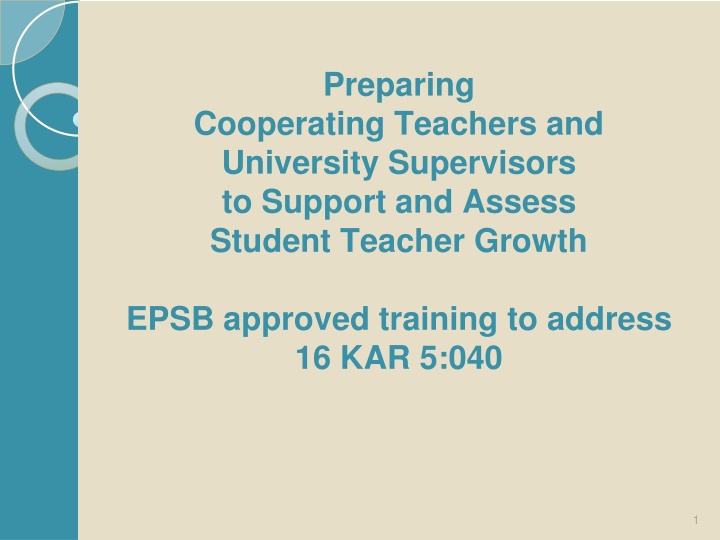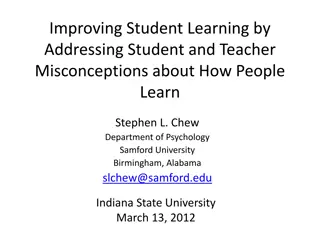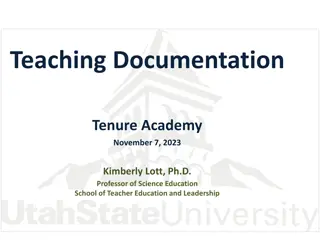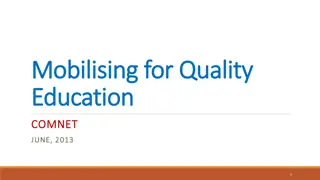
Supporting Student Teacher Growth: Training for Cooperating Teachers and University Supervisors
Engage in EPSB-approved training to enhance the support and assessment of student teachers. Learn about key roles, best practices, and strategies for fostering student teacher growth in this collaborative project involving EPPs, EPSB, KDE, and Jessamine County Public Schools.
Download Presentation

Please find below an Image/Link to download the presentation.
The content on the website is provided AS IS for your information and personal use only. It may not be sold, licensed, or shared on other websites without obtaining consent from the author. If you encounter any issues during the download, it is possible that the publisher has removed the file from their server.
You are allowed to download the files provided on this website for personal or commercial use, subject to the condition that they are used lawfully. All files are the property of their respective owners.
The content on the website is provided AS IS for your information and personal use only. It may not be sold, licensed, or shared on other websites without obtaining consent from the author.
E N D
Presentation Transcript
Preparing Cooperating Teachers and University Supervisors to Support and Assess Student Teacher Growth EPSB approved training to address 16 KAR 5:040 1
Primary Training Module Learning Targets/Objectives To review: The roles and responsibilities of student teaching triad members. The ingredients undergirding the term best practices Ways to support student teachers growth using co- teaching strategies and other best practice strategies. 4
A Collaborative Project involving representatives from: Educator Preparation Provider (EPPs) The Kentucky Education Professional Standards Board (EPSB) The Kentucky Department of Education (KDE) Jessamine County Public Schools Note: A list of Training Development Committee Members is included at the end of the training. 2
16 KAR 5:040 Section 1 (3) Prior to student teacher placement, a cooperating teacher shall receive training approved by the Education Professional Standards Board and provided at no cost to the cooperating teacher by the educator preparation institution which shall include the following components: (a) Basic responsibilities of a cooperating teacher; (b) Best practice in supporting the student teacher; (c) Effective assessment of the student teacher. 4
16 KAR 5:040 Section 4 (4) University supervisors shall receive training approved by the Education Professional Standards Board and provided at no cost to the university supervisor by the educator preparation institution which shall include the following components: (a) Basic responsibilities of a university supervisor; (b) Best practice in supporting the student teacher; (c) Effective assessment of the student teacher. 5
Training Module Terms with Abbreviations: Student Teacher (ST) Cooperating Teacher(CT) University Supervisor (US) Kentucky Teacher Performance Standards (KTPS) Kentucky Academic Standards (KAS) Professional Learning (PL) Professional Growth Plan (PGP) Educator Preparation Provider (EPP) 7
Framework for Growth The Kentucky Teacher Performance Standards (KTPS) form a framework for supervisors to guide and assess growth. You can view the KTPS at: http://www.epsb.ky.gov/mod/book/view.php?id=133 7
Key Elements of Effective Supervision Support Assessment Mentoring 8
Effective Supervision Focus Impact of instruction on student learning 10
Roles and Responsibilities of Triad Cooperating Teacher (CT) University Supervisor (US) Student Teacher (ST) Note: Please review handbook of EPP with which you are working for specific policies and procedures related to that program. 12
Specific Responsibilities for the CT: Preparing for the ST arrival. Welcoming the ST and designating work place. Orientating ST to classroom and school. Encouraging involvement in class and school activities. Creating a schedule for working together. Communicating clearly and constructively throughout placement. Modeling reflective teaching and professionalism. Observing and conferring frequently. Exercising flexibility, patience and understanding. Planning, delivering and reflecting regarding lessons together. Assessing progress and completing performance evaluations. What else comes to your mind? 12
Specific Responsibilities for the US: Conducting orientation for STs and CTs prior to start of placement to review policies and procedures.. Sharing course syllabus with ST and CT. Setting clear expectations for all involved. Conducting observations and conferences frequently. Discussing performance evaluations with ST and CT. Facilitating positive communication and interactions for all involved. What would you add? 12
Specific Responsibilities for the ST: Showing enthusiasm and interest. Taking initiative, sharing and asking thoughtful questions. Introducing him/herself to school community members. Acting in a respectful manner. Helping with all classroom activities. Participating in school activities. Maintaining a reflective stance. Accepting constructive feedback. Communicating clearly and constructively throughout placement. What else would you include? 12
Keeping an Eye on Best Practices for Supervision: Components and Resources High Leverage and Evidenced-based Practices The CEEDAR initiative Culturally Responsive Teaching KDE s CHETL Maranzo s Effective Strategies 20
Promoting Student and Teacher Learning with HLPs and EBPs High-leverage practices (HLPs) and evidence-based practices (EBPs) are used across subject areas, grade levels and contexts. They have been shown to: foster student learning. support social and emotional development. Advance teacher growth Additional information about these practices can be found at: http://ceedar.education.ufl.edu/wp-content/uploads/2017/12/HLPs-and- EBPs-A-Promising-Pair.pdf What HLPs do you see implemented in classrooms? 16
Culturally Responsive Teaching Culturally Responsive Teaching, one aspect of the CEEDAR work, is a critical part of best practices. Information about CRTs can be found at: http://ceedar.education.ufl.edu/wp- content/uploads/2014/08/culturally- responsive.pdf What culturally responsive practices do you find effective?
Considering CHETL Resources Characteristics of Highly Effective Teaching and Learning (CHETL) Developed by KDE in 2010 to enhance student learning and teacher efficacy. Detailed information about CHETL is available at: https://education.ky.gov/curriculum/standards/teachtools/Pages/Char acteristics-of-Highly-Effective-Teaching-and-Learning-(CHETL).aspx How does CHETL fit with other effective strategies?
Reflecting about Robert Marzanos Effective Strategies Consider the material available through the links below when explaining best practice to student teachers: https://www.marzanoresearch.com/research/database https://www.marzanoresearch.com/reproducibles/supporti ng-beginning-teachers Which ones do you think are most salient?
Supporting the ST with Best (Evidenced-based) Practices Emphasizes: actively engaging ST with CT in all aspects of instruction from the first day. planning, implementing instruction, and reflecting together (i.e., co-teaching). observing, conferring and documenting progress frequently. Providing formal feedback using performance evaluation instruments provided by the EPP. 20
Approaches to Co-Teaching Large Group Small Group One Teach/One Observe Station Teaching One Teach/One Assist Parallel Teaching Team Teaching Alternative Teaching For an explanation of each co-teaching strategy visit: http://ctserc.org/component/k2/item/50-six-approaches-to-co-teaching What implementation practices would you suggest? 21
Planning Together Includes: Designing effective instruction and assessments. Creating meaningful assessments. How will you co-plan? 64
Implementing together includes: Sharing responsibilities to actively engage students in learning 65
Reflecting Together Includes: Carefully analyzing student data. Considering next steps in instruction. Being proactive, not reactive. How will you co-reflect with your ST? 66
Observing Student Teachers: Some Data Collection Methods Scripting teacher s actions Tracking student engagement; e.g., Who participates? Who does not? What additional data collection methods will you use to share with the ST about observed lessons? 85
Co-reflection Strategy Examples: Identify significant data points. Interpret data in relation to student learning. Clarify ambiguous points. Consider growth areas for ST (PGP). Determine next steps. What other co-reflection strategies come to mind? 88
Together US and CT Review: Course syllabus regarding ST requirements. Performance evaluation tools and procedures. Professional Growth Plan. Communication procedures. Note: Candid conversations with constructive feedback are essential. What else would you like to include? 89
Assessment of ST Since ST performance evaluations are tailored to meet the goals of each EPP, the US will provide orientation to the assessment instrument(s) for that specific EPP. General references related to assessment of professional growth for Kentucky Teachers can be found at: Kentucky Teacher Performance Standards: http://www.epsb.ky.gov/mod/book/view.php?id=133 Kentucky Framework for Teaching: https://education.ky.gov/teachers/PGES/TPGES/Pages/Ken tucky-Framework-for-Teaching.aspx 94
Clear Communication: The Key to Success The Student Teaching Triad Student Teacher Communication Cooperating Teacher University Supervisor Planning, Implementing and Reflecting Together 89
Completion of evaluation survey REQUIRED You must send an email to the coordinator at the university with which you are associated with the information requested below. Contact information for the coordinator can be found at: http://www.epsb.ky.gov/mod/page/view.php?id=475 Your message must include both: a statement verifying that you have reviewed all the material in the training module. The statement may be as simple as: I am writing to verify that I have reviewed all the material in this training module . a brief narrative describing at least one idea gleaned from the training module to use when supervising student teachers.
THANKS! for participating and for your efforts to promote high quality teaching! Please note: Once you have completed the survey, you will receive a certificate from the EPP coordinator with whom you are associated. Note: The PowerPoint used to create this video can be accessed on the website you used to access this training. 96
Training Oversight Committee Sharon Brennan, University of Kentucky Tim Crook, Asbury University Brandon Harrod, EPSB/KDE Eve Proffitt, EPSB/KDE David Riel, Asbury University Alesa Walker, Murray State University Narration provided by: Angela Miller, Red Oak Elem., Jessamine Co. Lorenzo Villalobos, Wilmore Elem., Jessamine Co. Video provided by: Kaitlin Smith, Asbury University 2






















